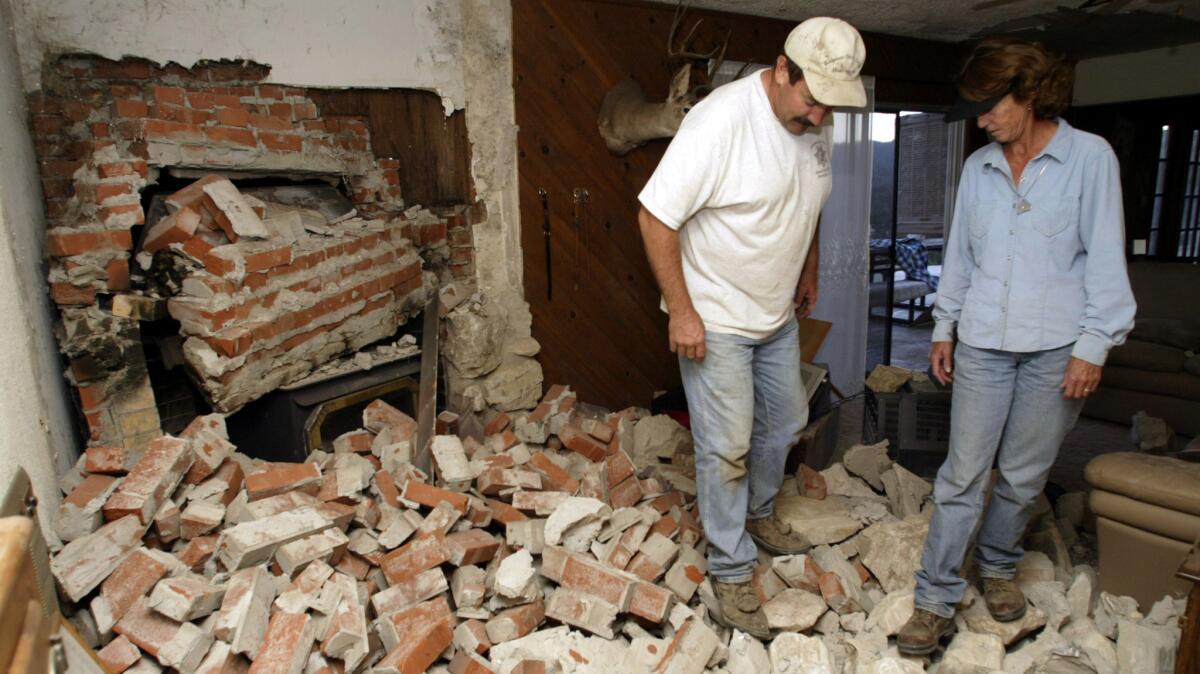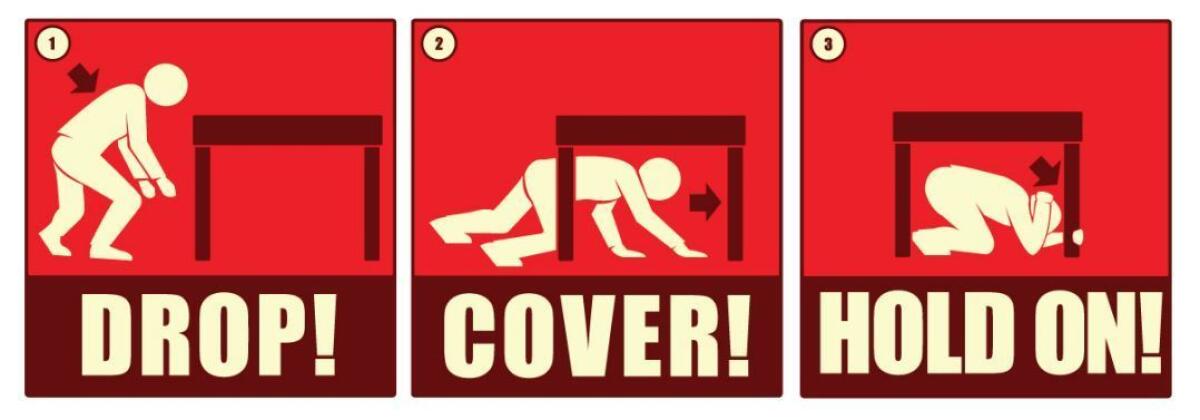Earthquake preparedness: What to do before — and during — a big one

- Share via
Two powerful earthquakes that hit Southern California this week have jolted many to think about how they can better prepare for a devastating temblor.
The quakes were the biggest in nearly two decades, and they were felt over a wide area.
So where to start to face the seismic threat?
1. Work on your home
• Go to a hardware store and find the tools you need to strap bookshelves to the wall, televisions to their stands and microwaves on countertops. People have died in past earthquakes after microwaves and televisions struck them.
Parents with toddlers often do the same thing to prevent a TV stand from toppling over a mischievous child climbing furniture.

• Install safety latches on kitchen cabinets — like the kind used to keep toddlers out — to keep blenders and plates from toppling on you.
• Use earthquake putty or museum wax to secure picture frames and vases to tabletops.
• Remove anything that could fall on your bed, like heavy frames or bookcases.
• Move your bed away from windows, which can shatter and cause cuts. You can also affix a safety film to windows that will leave shattered glass in place.
• Use earthquake-resistant picture hooks to keep frames from crashing in earthquakes. Affix the bottom corners with earthquake putty.
• If you want to go a step further, don’t use glass to cover pictures in the hallway. This is something seismologist Lucy Jones avoided so that her children, when they were younger, “could get to us without having to cross [broken] glass.”

• Save the wine! Consider storing wines in racks with individual slots and a lip to hold the neck of each bottle. Keep them low to the ground. Or store wine in wooden boxes, at most two stacks high. Read more here.
• Make sure your gas heater is secured to a wall.
• Install an automatic valve that shuts off the gas when shaking arrives in an earthquake, reducing the risk of a broken gas line igniting a fire.
• At the very least, learn how to shut off your gas manually. (Renters, ask your landlord where the gas is, too!) You can do it with a wrench. Better yet: Buy a tool and tie it around the gas valve, so you don’t have to go looking for a wrench just after the earthquake.
• Get a fire extinguisher or two; know where they are. Keep them visible, like on a kitchen counter away from the stove. Make sure everyone at home knows how to use them.
• Get emergency plug-in lights that automatically turn on during a power outage. Keep one near your bed.
• Tie some old shoes around your bed post, so you can walk around the home after an earthquake without slicing your feet on broken glass.
• Place an old pair of eyeglasses near your bed in a secure spot.
• Try to keep your gasoline tank three-quarters full. Gas stations require power to pump gasoline. No electricity, no gas.
• Phone and internet service could be disrupted. Texting will be an easier bet than making phone calls — and may be easier in the first few hours before cellphone towers drain their emergency battery power. Many cellphone towers have a battery supply that lasts as little as four hours, while critical towers have generators that can hold out for 48 hours. When Superstorm Sandy hit the New York area, about 25% of cell sites in the worst-hit region lost service because of power outages.
• Rely on Google Maps to navigate around town? Do this right now: Download maps of your city for offline access so you can use the navigation service even when cell service is down. Or buy some paper maps and learn, or relearn, how to read them. Better yet: learn how to get around without using your phone, and memorize alternate routes.
• Buy portable battery packs and use them and charge them all the time. They’ll be essential in an extended power outage.
• Take a class that teaches you how to perform CPR, first aid and the Heimlich maneuver and to use an automated external defibrillator, which are used for heart attack victims.

2. See if your home or business needs a retrofit
• Own a home? Hire a foundation specialist or structural engineer to see if anything needs to be done, such as bolting your home to the foundation so it doesn’t slide off in an earthquake. A $4,000 retrofit job now could head off a $400,000 repair job after the earthquake. The state-supported California Residential Mitigation Program offers grants of up to $3,000 to retrofit specific types of older single-family homes.
Related: Retrofitting pre-1979 homes can prevent much costlier quake damage »

•Also, consider the risk of your chimney.
Chimneys are a notorious risk in earthquakes, in which bricks come flying off during shaking. There are some retrofit options, but some experts say the safest way to deal with the hazard is to remove them.
In the 1992 Landers earthquake that struck the Mojave Desert, a 3-year-old boy in a sleeping bag next to the fireplace died after the upper half of the chimney came crashing down and struck him in the head. In another earthquake — a 5.2 temblor that hit Napa Valley in 2000 — a 5-year-old boy was left fighting for his life after he was buried by the fireplace during a birthday party sleepover. He survived, but underwent more than two dozen operations.
Even the lower half of a chimney can be a problem. A 13-year-old boy was struck by falling bricks from his chimney during a sleepover during the 2014 Napa earthquake. His pelvis was broken in six places.
Related: Often overlooked, brick chimneys pose hazards in quakes »

• Also, many wood apartment buildings across California have a vulnerability — car spaces on the ground floor, held up by skinny, flimsy columns that can collapse in an earthquake.
San Francisco and Los Angeles have laws in place to require retrofits, but most other local governments do not. Owners and renters should be aware of this vulnerability, and experts say a retrofit will save lives; an apartment complex with this problem killed 16 people on the ground floor of an apartment building during the 1994 Northridge earthquake.
Database: Do you know if your L.A. apartment is at risk in an earthquake? »
• Own or manage a large concrete or steel-frame building? Brittle concrete buildings can collapse in earthquakes, and L.A. and Santa Monica have laws on the books to require they be retrofitted. One type of steel-frame building also has flaws that can threaten them in shaking, and Santa Monica also requires that they be strengthened. In a major earthquake, hundreds could die in the collapse of high-rise steel buildings.
3. Drop, cover and hold on when an earthquake hits

California natives know this drill well: During an earthquake, drop to the floor and cover your neck and head with your hands, and get underneath a table and hold on!
Running out of the building is not a good idea, experts say, as the exterior of a building is one of the most dangerous places to be as objects fall.
During the 2003 Paso Robles earthquake, bricks came crashing down on two women fleeing the building; experts say if they had stayed inside, they would have survived.

In the Mexico City earthquake of 1985, desks remained standing at one building even as the ceiling caved in.
What happens if you can’t get under a desk? Get as low as possible, protect your head and neck, and move away from windows or other items that can fall on you. Here are more detailed instructions, via EarthquakeCountry.org:
• In a bed: Hold on and stay there, protecting your head with a pillow. Running is a bad idea — it's easy to get cut on broken glass on the floor.
• In a high-rise: Drop, cover, hold on. Avoid windows. Don't use elevators.
• In a theater or stadium: Stay in your seat or drop to the floor between rows, and protect your head, neck and arms. Don't try to leave until the shaking is over.
• In a store: Drop and take cover under anything that can provide protection, like a shopping cart or inside clothing racks. If you need to move away from heavy items on high shelves, drop to the ground first and crawl the shortest distance away. Whenever you enter a retail store, take a moment to see what could fall on you during an earthquake.
• Outdoors: Move to a clear area if you can safely do it. Avoid power lines, trees, signs, buildings and vehicles.
• Near the shore: If severe shaking lasts 20 seconds or more, head to high ground in case a tsunami has been generated. Move inland two miles or to land that is 100 feet above sea level. Don't wait for a warning, start walking. And don't drive, to avoid traffic.
4. Get a kit together
• Pack food, water, medicine and anything else you’d need for at least 72 hours, but several weeks is a better bet. And don’t forget about your pet.
• But don’t hide your stash where it’s forgotten and allowed the food to expire. Place it on a shelf that’s easily accessible. Key things to buy: canned proteins like fish, chicken or beans; canned fruit (which has sugar); and peanut butter, Jones said. If no earthquake hits, they can be donated to a food bank with plenty of time before the expiration date. Don’t forget about replacing plastic water jugs; they can degrade over time and leak.
More details at earthquakecountry.org.
• Consider keeping your car’s fuel tank half or three-quarters full at all times. A power outage will make it impossible to get fuel.
• Have a wad of cash that includes small bills at home and in your wallet. ATMs won’t work without electricity.
• If your food kit includes canned food, make sure you have a manual can opener.
Related: Is your home earthquake-ready? How to prepare for the Big One »
5. Consider earthquake insurance, and find out more about the hazards near your home
• Earthquake insurance can give homeowners the ability to have the funds to repair their homes quickly after a massive disaster; a typical homeowner policy won’t do so.
• Renters, too, can benefit, particularly if a disaster leaves their apartment uninhabitable; earthquake insurance can cover the cost of temporary housing.
• Find out more about the fault, liquefaction and landslide hazards close to your home. One free website, www.temblor.net, offers users a look at nearby earthquake faults and locations of liquefaction and landslide hazards as mapped by state officials.
More details can be found at earthquakecountry.org/prepare.
Sign up for Essential California
The most important California stories and recommendations in your inbox every morning.
You may occasionally receive promotional content from the Los Angeles Times.








